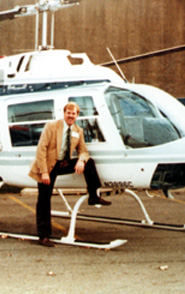|
Chuck Osborne:
Detailed Biography
Detailed
Biography
|
Biographical Highlights
Early Years
Military Career
Aviation Career
Post-Aviation Career
Family
Education
Osborne Family Genealogy
Aviation Career
Just as I had hoped, my training as a military helicopter
pilot opened the door to a civilian flight career — I became a
commercial pilot when I was hired to fly a candidate running for
Governor of Kentucky around the state of Kentucky in the final
weeks of the May 1979 primary election.
A few months later, I accepted my first corporate flight
position in the south-central Kentucky town of Somerset. The
flight department I headed up consisted of a twin-engine Piper
Aztec and a two-seat F-28A Enstrom helicopter (below).
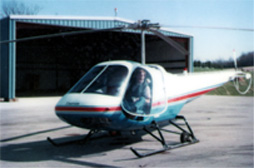 The F-28A Enstrom helicopter was soon replaced with a brand
new jet-powered Bell JetRanger III helicopter. The new JetRanger III cost in excess of
three-quarters of a million dollars when it was purchased and I
thrilled that my employers decided to buy the JetRanger. I
completed a three-day, factory-training course and a flight
checkout at the Bell Helicopter factory in Dallas, Texas, and
then flew the jet-powered JetRanger III helicopter back to
Kentucky. The F-28A Enstrom helicopter was soon replaced with a brand
new jet-powered Bell JetRanger III helicopter. The new JetRanger III cost in excess of
three-quarters of a million dollars when it was purchased and I
thrilled that my employers decided to buy the JetRanger. I
completed a three-day, factory-training course and a flight
checkout at the Bell Helicopter factory in Dallas, Texas, and
then flew the jet-powered JetRanger III helicopter back to
Kentucky.
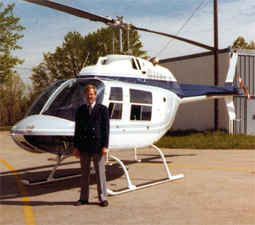 As the company’s only pilot, I also filled the role as the
company’s Chief Pilot. This included many roles that are often
handled by more than one individual in larger corporate flight
departments. These duties included tracking and scheduling
maintenance for the aircraft, upkeep of hangar facilities,
oversight of the fuel farm and many other details related to the
safe operation of a helicopter and a twin-engine airplane for a
corporation. As the company’s only pilot, I also filled the role as the
company’s Chief Pilot. This included many roles that are often
handled by more than one individual in larger corporate flight
departments. These duties included tracking and scheduling
maintenance for the aircraft, upkeep of hangar facilities,
oversight of the fuel farm and many other details related to the
safe operation of a helicopter and a twin-engine airplane for a
corporation.
I continued to build on my aviation credentials through the
years and moved on to higher paying positions flying larger and
faster aircraft. After nearly three years in Somerset, the
owners decided to shut down the flight department, and the
JetRanger III helicopter was sold. I soon found a position as a
First Officer for COMAIR, a scheduled airline out of the Greater
Cincinnati airport in northern Kentucky.
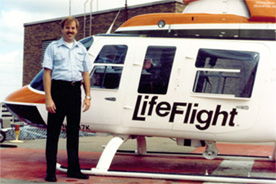 I left this position after a few months for a higher paying
job flying an emergency “LifeFlight” helicopter for a hospital
in Evansville, Indiana. The medevac helicopter was a “stretched”
version of the JetRanger III I had flown in Kentucky. It too was
manufactured by Bell Helicopter and was called a LongRanger.
This helicopter model was used by many hospital-based helicopter
medevac services. I left this position after a few months for a higher paying
job flying an emergency “LifeFlight” helicopter for a hospital
in Evansville, Indiana. The medevac helicopter was a “stretched”
version of the JetRanger III I had flown in Kentucky. It too was
manufactured by Bell Helicopter and was called a LongRanger.
This helicopter model was used by many hospital-based helicopter
medevac services.
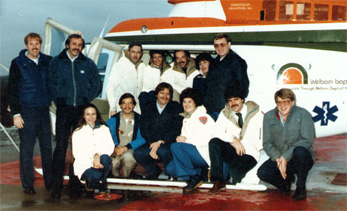 I flew medevac missions from the sixth-floor rooftop
helicopter pad on a wing of the hospital for nearly two years. I
transported patients to hospitals best able to treat their
injuries. Hospitals in Louisville, Kentucky; Indianapolis,
Indiana; and St. Louis, Missouri, were regular destinations. I
also made transports as far away as Chicago, Nashville, and
Springfield, Illinois. Springfield was quite memorable for me —
the helipad was located on the rooftop of a twenty-one-story
hospital wing! I flew medevac missions from the sixth-floor rooftop
helicopter pad on a wing of the hospital for nearly two years. I
transported patients to hospitals best able to treat their
injuries. Hospitals in Louisville, Kentucky; Indianapolis,
Indiana; and St. Louis, Missouri, were regular destinations. I
also made transports as far away as Chicago, Nashville, and
Springfield, Illinois. Springfield was quite memorable for me —
the helipad was located on the rooftop of a twenty-one-story
hospital wing!
A higher salary and an opportunity to fly larger, more
sophisticated aircraft led me to accept a flight position in
Moberly, Missouri, flying both airplanes and a helicopter. My
new employer owned both a cattle ranch and a coal company. The
flight department consisted of a Bell JetRanger helicopter,
a turbo-prop Beechcraft King
Air F90 airplane, and a second twin-engine airplane, called a Beechcraft Baron. The KingAir
F90 was pressurized and flew higher and faster than the
twin-engine Baron.
While flying for this Missouri flight department, I had the
opportunity to fly a number of interesting people. Some of the
more noteworthy passengers were Norm Stewart, a well known
long-time University of Missouri basketball coach; Willard
Scott, weatherman from the NBC morning news program “Today”;
Christopher S. “Kit” Bond, Missouri Governor and later senator;
John Ashcroft, Missouri Governor and the present U.S. Attorney
General; Clayton Yeuter, former Secretary of Agriculture and
U.S. Trade Representative; and 1980’s country music singer Lee
Greenwood.
A changing business climate led to the sale of some of this
flight department’s aircraft, and as a result I was forced to
look for a new employer late in the summer of 1985. Before
actually receiving a job layoff, I was able to find employment
with a large coal company that strip-mined coal in eastern
Kentucky.
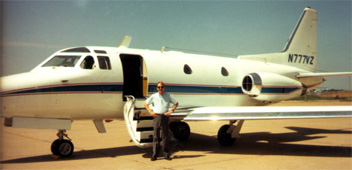 The new position not only brought me back home to Kentucky
but also gave me my first opportunity to fly a corporate jet.
The company owned a Sabreliner, Model 40 jet originally
manufactured by Rockwell International. Before I could start
flying the Sabreliner jet, I first needed flight training and a
type rating for the jet, which required two weeks of training at the
international training facility, Flight Safety, in St. Louis.
The training consisted of classroom and simulator training
followed by a check ride in the Sabreliner, which I passed. The new position not only brought me back home to Kentucky
but also gave me my first opportunity to fly a corporate jet.
The company owned a Sabreliner, Model 40 jet originally
manufactured by Rockwell International. Before I could start
flying the Sabreliner jet, I first needed flight training and a
type rating for the jet, which required two weeks of training at the
international training facility, Flight Safety, in St. Louis.
The training consisted of classroom and simulator training
followed by a check ride in the Sabreliner, which I passed.
 The company also owned a jet-powered helicopter called a
Gazelle and I was the only company pilot qualified to fly it.
The Gazelle built by the French aerospace
manufacturer, Aerospatiale, and was used to travel to the
company’s extensive land holdings and strip-mining operations
throughout eastern Kentucky. The company also owned a jet-powered helicopter called a
Gazelle and I was the only company pilot qualified to fly it.
The Gazelle built by the French aerospace
manufacturer, Aerospatiale, and was used to travel to the
company’s extensive land holdings and strip-mining operations
throughout eastern Kentucky.
The Sabreliner jet was used for executive transportation
throughout the United States and the Caribbean. One of my most
memorable trips in the Sabreliner was to the Central American
country of Belize. My boss owned an island off the coast of
Belize, and periodically would schedule vacation trips to the
island. The trips to Belize would generally layover for at least
several days and this provided ample time to enjoy scuba diving
and snorkeling. Trips to Belize were also a good opportunity to
cruise at the Sabreliner’ s maximum cruising altitude of 51,000
feet, which was higher than that of most corporate jets.
To become a captain on a larger corporate jet, I
decided in 1986 to relocate to a corporate flight department
based out of the Akron Canton airport. The flight crew position
began as a temporary copilot position aboard a
Falcon 20 jet
(Place Link to Falcon 20 – Gadsden, AL) , but soon turned into a
permanent position. The Falcon 20 is a medium-size business jet
built by Dassault Aviation of France.
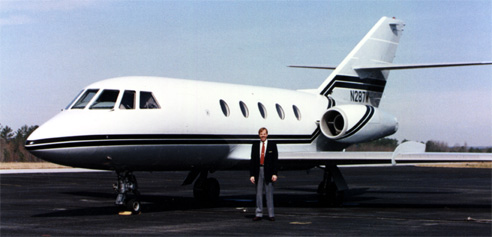
Here I am with the Falcon 20 at the Akron
Canton Airport
After a few months copiloting the Falcon 20, I received two
weeks of flight training to get my type rating for the Falcon 20
jet. All of the flight training took place in simulators at a
training facility located at DFW airport in Dallas, Texas,
called Simuflite International. Since I already had previous
jet experience and a jet type rating, I was permitted to take my
check ride in a flight simulator. I completed the check ride in
the simulator and received my type rating for the Falcon 20 in
January 1987.
I had a particularly memorable flight on September 23, 1987.
I flew retired Justice of the Supreme Court Arthur Goldberg back
to Washington DC’s Dulles airport and, while waiting for the
arrival of Justice Goldberg’s limousine, we chatted.
I learned from Justice Goldberg that President John F.
Kennedy had appointed him to a seat on the Supreme Court in
1962. Justice Goldberg confided to me that he missed President
Kennedy, even though it had been nearly 24 years since
the President’s death. I learned later that the former Supreme
Court Justice had also served as the Secretary of Labor in the
Kennedy Administration.
 Return to Top |
Next to
Post-Aviation Career
Return to Top |
Next to
Post-Aviation Career
|


